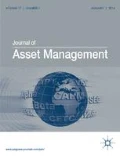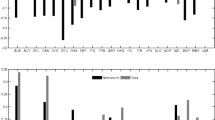Abstract
This paper studies the predictive performance of multivariate models at forecasting the (excess) returns of portfolios mimicking the Market, Size, Value, Momentum, and Low Volatility factors isolated in asset pricing research. We evaluate the accuracy of the point forecasts of a number of linear and regime-switching models in recursive, out-of-sample forecasting experiments. We assess the accuracy of the models using several measures of unbiasedness and predictive accuracy, and using Diebold and Mariano’s approach to test whether differences in expected losses from all possible pairs of forecast models are statistically significant. We fail to find evidence that complex statistical models are uniformly more accurate than a naïve constant expected return model for factor-mimicking portfolio (excess) returns. However, we show that it is possible to build simple portfolio strategies that profit from the higher out-of-sample predictive accuracy of forecasting models with Markov switching in conditional mean coefficients. These results appear to be independent of the forecasting horizon and robust to changes in the loss function that captures the investors’ objectives.
Similar content being viewed by others
References
Ang, A. (2014) Asset Management: A Systematic Approach to Factor Investing. Oxford University Press.
Ang, A. and Timmermann, A. (2012). Regime changes and financial markets. Annual Review of Financial Economics 4: 313–337.
Ang, A., Goetzmann, W.N. and Schaefer, S.M. (2010). The efficient market theory and evidence: implications for active investment management. Foundations and Trends in Finance 5: 157–242.
Angelidis, T. and Tessaromatis, N. (2014) Global portfolio management under state dependent multiple risk premia. In: Proceedings of Economics and Finance Conferences (No. 0400966). International Institute of Social and Economic Sciences.
Arnott, R., Kelso, C., Kiscadden. R. and Macedo, R. (1989) Forecasting factor returns: an intriguing possibility. Journal of Portfolio Management 16: 28–35.
Black, A.J. and McMillan, D.G. (2004). Non‐linear predictability of value and growth stocks and economic activity. Journal of Business Finance & Accounting 31: 439–474.
Blitz, D.C. and van Vliet, P. (2007) The volatility effect. The Journal of Portfolio Management 34: 102–113.
Bollerslev, T. and Wooldridge, J.M. (1992). Quasi-maximum likelihood estimation and inference in dynamic models with time-varying covariances. Econometric Reviews 11: 143–172.
Buckley, I., Saunders, D. and Seco, L. (2008) Portfolio optimization when asset returns have the Gaussian mixture distribution. European Journal of Operational Research 185: 1434–1461.
Campbell, J.Y. and Cochrane, J.H. (2000). Explaining the poor performance of consumption‐based asset pricing models. Journal of Finance 55: 2863–2878.
Campbell, J.Y. and Yogo, M. (2005) Implementing the econometric methods in “Efficient tests of stock return predictability”. Unpublished working paper. University of Pennsylvania.
Carhart, M.M. (1997) On persistence in mutual fund performance. Journal of Finance 52: 57–82.
Chan, K.S. (1993) Consistency and limiting distribution of the least squares estimator of a threshold autoregressive model. The Annals of Statistics 21: 520–533.
Chen, L., Petkova, R. and Zhang, L. (2008). The expected value premium. Journal of Financial Economics 87: 269–280.
Chordia, T. and Shivakumar, L. (2002). Momentum, business cycle, and time‐varying expected returns. Journal of Finance 57: 985–1019.
Cochrane, J.H. (2008) The dog that did not bark: A defense of return predictability. Review of Financial Studies 21: 1533–1575.
Cohen, R. B., Polk, C. and Vuolteenaho, T. (2003) The value spread. Journal of Finance 58:609–642.
Cooper, M.J., Gutierrez, R.C. and Hameed, A. (2004) Market states and momentum. Journal of Finance 59: 1345–1365.
DeMiguel, V., Garlappi, L. and Uppal, R. (2009). Optimal versus naive diversification: How inefficient is the 1/N portfolio strategy? Review of Financial Studies 22(5): 1915–1953.
Dempster, A.P., Laird, N.M. and Rubin, D.B. (1977) Maximum likelihood from incomplete data via the EM algorithm. Journal of the Royal Statistical Society. Series B 39: 1–38.
Diebold, F.X. and Lopez, J.A. (1996) Forecast evaluation and combination. In: Maddala and Rao (eds.) Handbook of Statistics. Amsterdam: Elsevier.
Diebold, F. and Mariano, R. (1995) Computing predictive accuracy. Journal of Business and Economic Statistics 13: 253–263.
Doan, T., Litterman, R. and Sims, C. (1984) Forecasting and conditional projection using realistic prior distributions. Econometric Reviews 3: 1–100.
Fama, E.F. (1990) Stock returns, expected returns, and real activity. Journal of Finance 45(4): 1089–1108.
Fama, E.F. and French, K.R. (1988) Dividend yields and expected stock returns. Journal of Financial Economics 22(1): 3–25.
Fama, E.F. and French, K.R. (1993) Common risk factors in the returns on stocks and bonds. Journal of Financial Economics 33: 3–56.
Fama, E.F. and French K.R. (1995) Size and book‐to‐market factors in earnings and returns. Journal of Finance 50: 131–155.
Fama, E.F. and French, K.R. (2002) The equity premium. Journal of Finance 57(2): 637–659.
Fama, E.F. and French, K.R. (2010) Luck versus skill in the cross‐section of mutual fund returns. Journal of Finance 65: 1915–1947.
Ferson, W., Siegel, A.F. and Xu, P.T. (2006) Mimicking portfolios with conditioning information. Journal of Financial and Quantitative Analysis 41: 607–635.
Giacomini, R. and White, H. (2006) Tests of conditional predictive ability. Econometrica 74: 1545–1578.
Guidolin, M. (2012). Modelling, estimating and forecasting financial data under regime (Markov) switching. Working paper, Bocconi University.
Guidolin, M. and Ono, S. (2006) Are the dynamic linkages between the macroeconomy and asset prices time-varying? Journal of Economics and Business 58: 480–518.
Guidolin, M. and Timmermann, A. (2006). An econometric model of nonlinear dynamics in the joint distribution of stock and bond returns. Journal of Applied Econometrics 21: 1–22.
Guidolin, M. and Timmermann, A. (2008) International asset allocation under regime switching, skew, and kurtosis preferences. Review of Financial Studies 21: 889–935.
Guidolin, M. and Timmermann, A. (2008) Size and value anomalies under regime shifts. Journal of Financial Econometrics 6: 1–48.
Guidolin, M., Hyde, S., McMillan, D. and Ono, S. (2009) Non-linear predictability in stock and bond returns: When and where is it exploitable? International Journal of Forecasting 25: 373–399.
Gulen, H., Xing, Y. and Zhang, L. (2011) Value versus growth: time‐varying expected stock returns. Financial Management 40: 381–407.
Hamilton, J.D. (1990) Analysis of time series subject to changes in regime. Journal of econometrics 45: 39–70.
Hamilton, J.D. (1994). Time series analysis. Princeton: Princeton University Press.
Hansen, B.E. (2000). Sample splitting and threshold estimation. Econometrica 68: 575–603.
Haugen, R.A. and Baker, N.L. (1991) The efficient market inefficiency of capitalization-weighted stock portfolios. Journal of Portfolio Management 17: 35–40.
Hong, Y. and Lee, T.H. (2003) Inference on predictability of foreign exchange rates via generalized spectrum and nonlinear time series models. Review of Economics and Statistics 85: 1048–1062.
Ilmanen, A. (2011). Expected Returns: An Investor’s Guide to Harvesting Market Rewards. John Wiley & Sons.
Inoue, A. and Kilian, L. (2005) In-sample or out-of-sample tests of predictability: which one should we use? Econometric Reviews 23: 371–402.
Kim, D., Roh, T.Y., Min, B.K. and Byun, S.J. (2014). Time-varying expected momentum profits. Journal of Banking & Finance 49: 191–215.
Krolzig H.-M. (1997) Markov-Switching Vector Autoregressions: Modelling, Statistical Inference, and Applications to Business Cycle Analysis (Lecture Notes in Economics and Mathematical Systems), vol. 454. Berlin: Springer.
Leroux, B.G. (1992) Maximum-likelihood estimation for hidden Markov models. Stochastic Processes and their Applications 40: 127–143.
Lintner, J. (1965). The valuation of risk assets and the selection of risky investments in stock portfolios and capital budgets. Review of Economics and Statistics 47: 13–37.
Lynch, A. (2000). Portfolio choice and equity characteristics: characterizing the hedging demands induced by return predictability. Journal of Financial Economics 62: 67–130.
Marcellino, M., Stock, J.H. and Watson, M.W. (2006). A comparison of direct and iterated multistep AR methods for forecasting macroeconomic time series. Journal of Econometrics 135: 499–526.
Merton, R.C. (1973) An intertemporal capital asset pricing model. Econometrica 41: 867–887.
Mincer, J.A. and Zarnowitz, V. (1969) The evaluation of economic forecasts. In Economic Forecasts and Expectations: Analysis of Forecasting Behavior and Performance (pp. 3–46). NBER.
Panopoulou, E. and Plastira, S. (2014) Fama French factors and US stock return predictability. Journal of Asset Management 15: 110–128.
Perez-Quiros, G. and Timmermann, A. (2000) Firm size and cyclical variations in stock returns. Journal of Finance 55: 1229–1262.
Pesaran, M.H. and Timmermann, A. (1995). Predictability of stock returns: Robustness and economic significance. The Journal of Finance 50(4): 1201–1228.
Rapach, D.E. and Wohar, M.E. (2006). In-sample vs. out-of-sample tests of stock return predictability in the context of data mining. Journal of Empirical Finance 13: 231–247.
Rapach, D.E., Wohar, M.E. and Rangvid, J. (2005). Macro variables and international stock return predictability. International Journal of Forecasting 21: 137–166.
Roeder, K. and Wasserman, L. (1997). Practical Bayesian density estimation using mixtures of normals. Journal of the American Statistical Association 92: 894–902.
Sarwar, G., Mateus, C. and Todorovic, N. (2015) Macroeconomic determinants of cyclical variations in value, size and momentum premiums in the UK. Size and Momentum Premiums in the UK, working paper, Cass Business School.
Sharpe, W. F. (1964) Capital asset prices: A theory of market equilibrium under conditions of risk. Journal of Finance 19: 425–442.
Stivers, C. and Sun, L. (2010) Cross-sectional return dispersion and time variation in value and momentum premiums. Journal of Financial and Quantitative Analysis 45: 987–1014.
Tong, H. (1983) Threshold models in non-linear time series analysis. Lecture Notes in Statistics, No. 21.
Tsay, R.S. (1998) Testing and modeling multivariate threshold models. Journal of the American Statistical Association 93: 1188–1202.
van Dijk, D. and Franses, P.H. (2003) Selecting a nonlinear time series model using weighted tests of equal forecast accuracy. Oxford Bulletin of Economics and Statistics 65: 727–744.
Wang, K.Q. and Xu, J. (2015). Market volatility and momentum. Journal of Empirical Finance 30: 79–91.
Zakamulin, V. (2013) Forecasting the size premium over different time horizons. Journal of Banking & Finance 37: 1061–107.
Zakamulin, V. (2014) Predictable dynamics in the Small Stock Premium. Economics Research International 2014: 1–12.
Acknowledgements
We would thank one anonymous referee for helpful comments and suggestions to improve the paper.
Author information
Authors and Affiliations
Corresponding author
Rights and permissions
About this article
Cite this article
Chincoli, F., Guidolin, M. Linear and nonlinear predictability in investment style factors: multivariate evidence. J Asset Manag 18, 476–509 (2017). https://doi.org/10.1057/s41260-017-0048-5
Revised:
Published:
Issue Date:
DOI: https://doi.org/10.1057/s41260-017-0048-5




